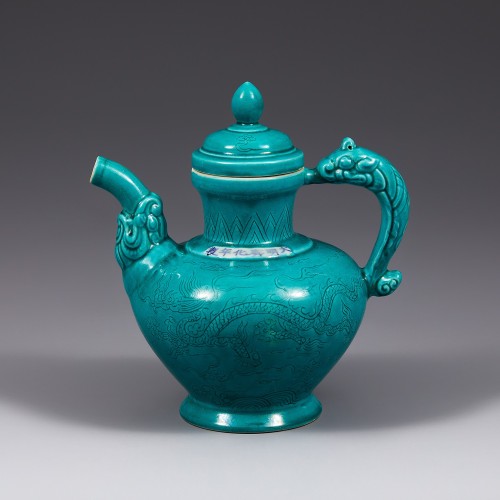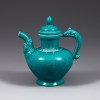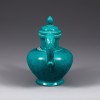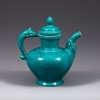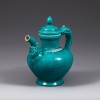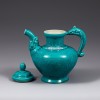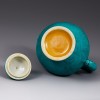본문
명나라 성화 연간(1464~1487)에 제작된 운룡문(雲龍紋) 공작유(孔雀釉) 주자입니다. 전면에는 구름 사이를 비상하는 용 문양이 음각되어 있고, 그 위로 청록색 유약이 시유되어 맑고 깊은 색감을 드러냅니다. 공작새 깃털을 연상시키는 색감으로 인해 ‘공작유(孔雀釉)’라고 불립니다. 주구와 손잡이에는 용두(龍頭)를 조형하여 미감을 더하였고, 손잡이 상단에는 끈을 걸 수 있는 고리가 있어 사용의 편의 또한 고려된 형태로 보입니다.
운룡문은 황제의 권위와 천명(天命)을 상징합니다. 특히 발톱이 다섯 개인 오조룡(五爪龍)은 황제를 상징하는 최고위 문양으로, 일반이나 지방 가마에서는 거의 확인되지 않습니다. 또한 생장을 상징하는 청색과 어우러져 길상의 의미를 더욱 강조합니다.
어깨에는 ‘大明成化年製(대명성화년제)’라는 명문이 시문되어 있어 제작 시기를 성화 연간으로 추정할 수 있습니다. 성화 연간은 단색유 채색 기술이 발전한 시기이며, 특히 청록·황색 유약이 궁정 기물에 널리 쓰였습니다. 정밀한 음각 문양, 공작유의 맑고 깊은 발색, 오조룡 문양, 명문 표기의 조합은 이 유물이 단순한 일상용이 아니라 황실의 권위와 상징성을 드러내기 위해 제작된 유물임을 나타냅니다.
━━━━━
这是明成化年间(1464~1487年)制作的云龙纹孔雀釉执壶。器物正面以浅浮雕技法刻绘出腾云驾雾的龙纹,施以青绿色釉料,釉色清澈深远,因其色彩与孔雀羽毛相似,故称“孔雀釉”。器身的注口与把手饰以龙首造型,增添美感,把手顶部设有挂绳孔,兼具使用便利性。
云龙纹象征皇权与天命,尤其五爪龙为皇帝专用,民间及地方窑十分稀少。同时与象征生长的青绿色相映衬,更突显吉祥的寓意。
肩部署“大明成化年制”款识,推测制作于成化年间。成化时期正值单色釉上彩技术发展时期,青绿釉与黄釉广泛用于宫廷器物。本件器物结合精美的浅浮雕纹饰、孔雀釉的清亮釉色、五爪龙纹及款识,显示其非日常用器,而是彰显皇室权威与象征意义的宫廷珍品。
━━━━━
This ewer, glazed in peacock color with a cloud and dragon design, was made during the Chenghua reign (1464–1487) of the Ming dynasty. A dragon flying among clouds is incised on the front and covered with a translucent turquoise glaze that gives off a deep, luminous tone reminiscent of a peacock’s feathers—hence the name peacock glaze. The spout and handle are shaped like dragon heads, enhancing both aesthetics and symbolism. A small loop at the top of the handle likely served to fasten a cord for ease of use.
The cloud and dragon motif symbolizes the emperor’s authority and divine mandate, while the five-clawed dragon in particular signifies imperial sovereignty—an emblem strictly reserved for the emperor and rarely found in regional kilns. The pairing of the blue-green glaze further emphasizes auspiciousness and vitality.
An inscription reading “Da Ming Chenghua nianzhi” (Made during the Chenghua reign of the Great Ming) appears on the shoulder, confirming its date. The Chenghua period marked a high point in monochrome glaze technology, especially in the refinement of turquoise and yellow glazes used for imperial wares. The precise incised motifs, rich peacock glaze, imperial dragon imagery, and reign mark together reveal that this ewer was not an everyday vessel but a symbol of royal prestige and authority.
